Country Information - Islamic Republic of Pakistan (Part 2) اسلامی جمہوریۂ پاکستان
Journey of Pakistani Currency
From "Ana" to Paisa and to Rupee
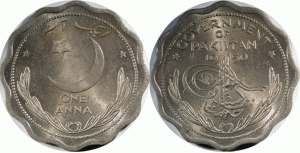

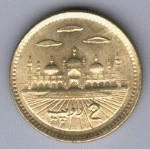
When Pakistan was carved out of the British India on 14 August 1947, it had no currency notes or coins of its own, nor a central bank or mint to print paper currency or mint coins. In order to cope up with the requirement of the new country, the Governor General of undivided India issued the ‘Pakistan (Monetary System and Reserve Bank) Order, 1947’ on 14 August 1947, the day before partition. Under this order, the Reserve Bank of India was to act as the common currency authority for India and Pakistan until 30 September 1948, allowing a cushion period of almost a year for the newly born state to issue its own currency. As an interim arrangement, the currency notes and coins issued by the Reserve Bank of India and the Government of India were to be the legal tender in Pakistan.
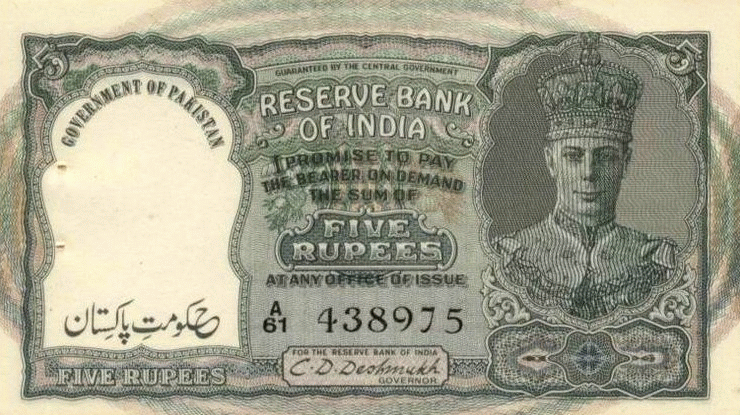

Thus the currency of the Indian Reserve Bank was inscribed with words "Government of Pakistan" both in Urdu and English, and placed into circulation from 1 April 1948 under the responsibility of the Government of Pakistan. So, following a seven-month period where notes of the Reserve Bank of India and the Government of India continued to circulate in Pakistan, modified notes of the Reserve Bank of India in the denominations of 2, 5, 10 and 100 rupees were introduced as planned, along with modified 1-rupee notes of the Government of India. The Indian currency consisted of two inscriptions on the front of the notes: at the top of the white area reserved for viewing the watermark the words "GOVERNMENT OF PAKISTAN" were inscribed in English, while at the bottom of the white area the Urdu rendition of the same phrase appears, i.e. "Hakoomat-e-Pakistan". For these inscriptions, the printing plates were modified, instead of overprints to avoid forgery.

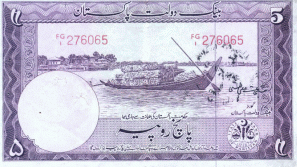
In the meantime, the Pakistan government tasked its Finance Ministry to set up the country's own state bank by 1 July 1948. Despite the scarcity of staff, since most of the non-Muslims workers had left for India and resources, the Pakistani staff took upon themselves it as a challenge to set up the state bank three months in advance of the dead date of September 1948. The government issued the "State Bank of Pakistan Order, 1948" on 12 May 1948 under the authority vested in the Governor General of Pakistan by the provisions of Section 9 of the Indian Independence Act, 1947. Once the State Bank had been established, the efforts intensified to issue Pakistan's own currency much before the given date.

The initial set of bank notes, in the denominations of 5, 10 and 100 rupees, was prepared by Thomas De La Rue & Company of Great Britain. The 5-rupee note was deep blue, the 10-rupee in red, and the 100-rupee note was in rich green colour. To the right, on the front of each note, was a crescent and star in an oval, while to the left the denomination of each note was written in Urdu numerals in a similar oval. The denomination was repeated in Urdu at the bottom centre and in western numerals at the bottom right. On the front of the notes were panels at the bottom with the Urdu words for ‘Government of Pakistan’ repeated in small text. Until 1952 the notes produced for Pakistan had come from a variety of sources. The inscribed notes of the Reserve Bank of India, which were printed at the Government of India’s Security Printing Press at Nasik. The first issue of Rs. 5, 10 and 100-rupee notes was produced by Thomas De La Rue and Company in Great Britain, while the Re. 1- and Rs. 2 notes were produced in Great Britain by Bradbury Wilkinson and Company.
After settling down with the issue of the requisite currency, the next step was the setting up of the first Security Printing Press under the Pakistan Security Printing Corporation at Karachi. The press was owned partially by the British security printing company Thomas De La Rue & Co. Ltd. (40%) and partially by the Government of Pakistan (60%). The paid up capital for the Corporation was 7.5 million rupees. The foundation stone for the new printing works was laid in Karachi by the Muhammad Ali Jinnah, the Governor General of Pakistan, on 11 March 1949.
Till 1960, when Pakistan adopted the metric system, one Pakistani rupee had 16 ana and each ana having 4 paisa, i.e. one rupee having 64 paisas. And as for the coins, there were coins of one, two paisa, one ana, two ana, 4 ana, 8 ana and one rupia (rupee). Thus, one ana was the basic coin (below left two sides of one ana, 2 ana and 8 ana).

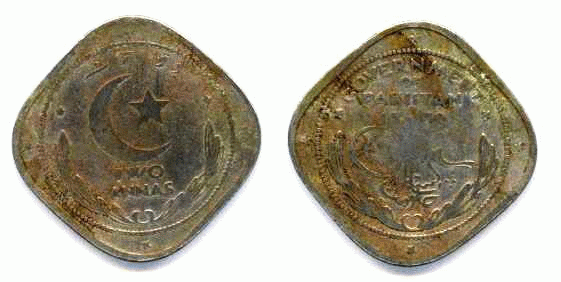
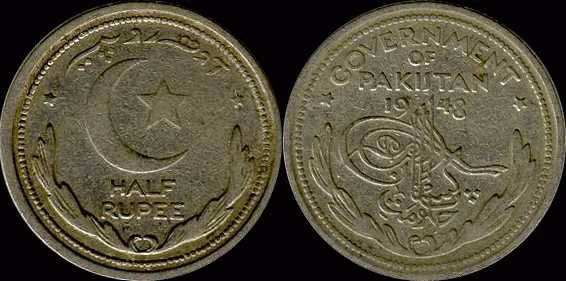
Then in 1960, the country switched to metric system and now one Pakistani rupee had 100 paisa. The coins were of one, two, five, 10, 25, 50 paisa. Later a coin of one rupee was also added. Currency notes of 1,2,5,10,50,100 and 500 have been in use for quite sometime now.
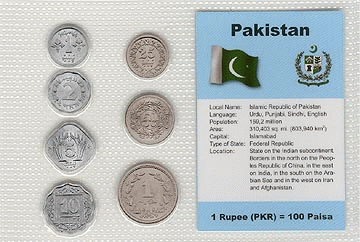
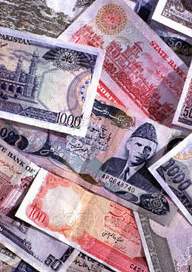
The present currency notes in circulation of Rs.10,50,100 and 500 denominations are as under:
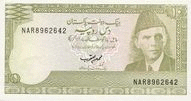



Lately, owing to the diminishing value of the sub divisions of one rupee, not only the currency notes of one, two and five have been replaced with coins, but also all coins of lower than one rupee have ceased to be of any value and are not in circulation anymore. Recently, currency notes of 20 and 5000 have been added to the inventory. These notes have many security features included in these and chances of forgery have almost been made negligible.
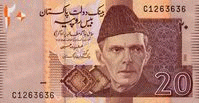

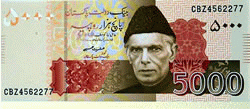
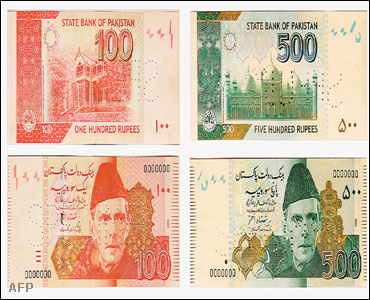
On 10 November State Bank of Pakistan issued new currency notes of 100 and 500 rupees denomination. These notes carry special identification features for the blind and will go a long way to counter the fake currency notes already in circulation in the country. The back of Rs. 100 note sketch of Ziarat Residency where Quaid-e-Azam spent his last days, while Badshahi Mosque of Lahore appears on the back of Rs. 500 note. (photograph courtesy AFP). There was a lot of hue and cry when the State Bank revised the Rs.20/- banknote since it was very similar to the Rs.5000/- since even the literates sometimes got confused and gave away a Rs.5000/- note instead of a Rs.20/- note. Now a new design and colour of Rs. 20 note is in circulation. The Five rupee note has also been reintroduced as it is quite cumbersome to carry a coin of five rupee.
![]() The State Bank of Pakistan has issued new coins of Rs.1 and Rs.2 denomination with, changed metal composition, colour and weight effective from November 20. The design of changed metal will be same as of the coins introduced from September 1998. The existing coins of Rs.1 and Rs.2 in circulation will continue to be legal tender and remain in circulation. Rs.1 coin will be of aluminum, white colour with 20 mm diameter having 1.75 grams weight where as Rs.2 coin will of aluminum white having 22.5 mm diameter with 2.6 gram weight. The new composition of coins was approved by the Federal Cabinet in its meeting on January 2007.
The State Bank of Pakistan has issued new coins of Rs.1 and Rs.2 denomination with, changed metal composition, colour and weight effective from November 20. The design of changed metal will be same as of the coins introduced from September 1998. The existing coins of Rs.1 and Rs.2 in circulation will continue to be legal tender and remain in circulation. Rs.1 coin will be of aluminum, white colour with 20 mm diameter having 1.75 grams weight where as Rs.2 coin will of aluminum white having 22.5 mm diameter with 2.6 gram weight. The new composition of coins was approved by the Federal Cabinet in its meeting on January 2007.
Economy of Pakistan
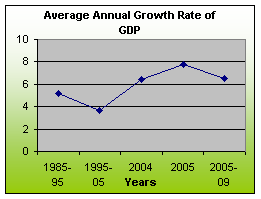
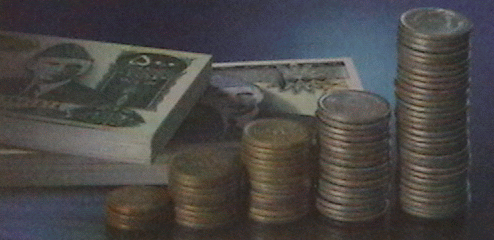
 At the time of independence, the economy of the newly born state was abysmal, since during the British times, all industrial infrastructure was laid in what constituted India in 1947. Although Pakistan had inherited 20 per cent of the subcontinent's population, her share in industry was less than 7 per cent, consisting mostly of small-scale and minor industrial units: the 34 factories did not total up to a daily employment of more than 26, 400 persons. The East wing which produced 70 per cent of the world's jute, had not a single jute mill since all jute mills were located in Calcutta, India and was thus the almost sole buyer. In the West wing, only 16000 of the total 1500000 cotton bales produced could be processed domestically. Pakistan did not have a single ordinance factory and other major industrial units. The new state does not have its own bank and depends on the reserve bank of India.
At the time of independence, the economy of the newly born state was abysmal, since during the British times, all industrial infrastructure was laid in what constituted India in 1947. Although Pakistan had inherited 20 per cent of the subcontinent's population, her share in industry was less than 7 per cent, consisting mostly of small-scale and minor industrial units: the 34 factories did not total up to a daily employment of more than 26, 400 persons. The East wing which produced 70 per cent of the world's jute, had not a single jute mill since all jute mills were located in Calcutta, India and was thus the almost sole buyer. In the West wing, only 16000 of the total 1500000 cotton bales produced could be processed domestically. Pakistan did not have a single ordinance factory and other major industrial units. The new state does not have its own bank and depends on the reserve bank of India.
However, starting from scratch and collecting papers from rubbish, the Pakistani officials and office staff picked bits and pieces together and started building up the new country. Now after some six decades, Pakistan is a fast growing country. Pakistan witnessed a steady pace of economic growth in the 60s with major thrust on agro-based industry, specially cotton, which however slowed down in the 80s/90s due to inept governments. However for the first time after the 60s, the steps taken at the macro level by the present government under General Pervez Musharraf, the economic outlook of the country has brightened and finally there is a hope of prosperity for its generally poor people. Since 1999, the foreign exchange reserves have swelled from disgusting US $ 500 million (when the country was being governed by the "democratically elected government") to over US $ 12 billion. For the first time the exports have crossed US $ 1 billion mark.
| Pakistan Tops Dollar Bond Performance in Asia 24-04-2009: Despite continued uncertainty, the world's largest dollar bond investors are continuing to maintain holdings in Pakistan. According to HSBC, Pakistani bonds have returned 35 percent this year, the best performance in Asia among dollar debt indexes compiled by London-based HSBC. ING Groep NV, Erste Sparinvest KAG and HSBC Holdings Plc, which oversee more than $800 billion in assets, are maintaining holdings of Pakistan's dollar bonds as almost $13 billion in assistance from the International Monetary Fund and aid pledges help the country stave off default. Pakistan's 6.875 percent dollar bond maturing in June 2017 yielded 18.62 percent yesterday, versus a record high of 26.30 percent on Nov. 3, 2008, according to data compiled by Bloomberg. The Karachi stock index is up 27 percent this year, compared with a 12 percent gain in MSCI's emerging-market stock index. Pakistan also won promises this month for $5.3 billion in aid from more than 20 countries to help shore up its economy and combat al-Qaeda and Taliban militants.( Reference ) |
| Past and the Present | |
| The Past Under the Military Regime | The Present (and the Future?? ) |
| The military rule that stretched from 1999 to early 2008, had many ups and finally a bleak down. From thriving economy and building of Forex reserves from mere US $ 500 miilion to all time US $ 16 billion, lot of water flowed under the bridge. As per the Ministry of Finance, Government of Pakistan, despite an extra-ordinary surge in oil prices and the devastation caused by the earthquake of October 8, 2005 Pakistan's economy continued to maintain a solid pace of expansion in 2005-06. Pakistan's economy has proved itself as remarkably resilient in the face of shocks of extra-ordinary proportions. The magnitude of growth that Pakistan has achieved during the last four years in a row has positioned Pakistan as one of the fastest growing economies in the Asian region. This growth momentum is underpinned by wide-ranging structural reforms, macroeconomic stability, and consistency and continuity in policies. The GDP growth remained in the 6-8% range in 2004-06. In 2005, the World Bank named Pakistan the top reformer in its region and in the top 10 reformers globally. Pakistan has three stock exchanges, established each in Karachi, Lahore and Islamabad. The Karachi Stock Exchange (KSE) is the more dynamic and volume based as compared to the rest of the two. The KSE was initially 50 50 companies based, but was elevated to KSE-100 on 1 November, 1991 and presently ranks as one of the most accepted Exchange in the region. The KSE-100 is a capital weighted index and represents about 86 percent of market capitalization of the Exchange. In 1995 the KSE all share index was constructed and introduced on September 18. The KSE has seen an up rise trend recently, though after crossing 10,000 mark, it plummeted a few months ago, crashing billions of rupees of investors. However, it has again picked up and at this time, the KSE-100 index has crossed 11,000 mark. The Lahore (LSE) and Islamabad (ISE) stock markets are heavily affected by performance of KSE - in fact all three stock exchanges rise and fall together. Karachi Stock Exchange was declared as the "Best Performing Stock Market of The World" in 2002. KSE has been well into the 3rd year of being one of the Best Performing Markets of the world as declared by the international magazine "Business Week". Similarly the US newspaper, USA Today, termed Karachi Stock Exchange as one of the best performing bourses in the world. | However, soon cracks started appearing in the economy in the early 2008, mainly due to soaring oil prices and which multiplied the oil bill many times. Suddenly a well meaning economy started to crumble - The inflation which continued to rise in previous years, though at a lower pace, suddenly jumped to almost 29% in 2008 as compared to 9% in 2005 The rupee currently stands at 80 against one US dollar whereas just six months ago, one dollar was equal to Rs 60. The country's trade deficit stands at 12 billion dollars, which is the highest ever in its 61-year old history. The country's stock exchanges are at all time low and there is no signs of recovery. Once thriving KSE-100 index of over 15000 points is at a record low around 9,187 on 21 November 2008. The 2008 onwards, Pakistan's economic is nose diving rapidly and alarmingly. The State Bank of Pakistan, though enforced tighter monetary grip, could not harness the growing inflation and the current account deficit - driven by a widening trade gap as import growth outstrips export expansion - and had to draw down reserves and dampen GDP growth in the medium term. As of now, Pakistan urgently needs at least $3 billion -- and as much as $5 billion and has requested the IMF for as much as $10 billion. "If Pakistan doesn't get the money, there may be a repeat of freezing foreign currency accounts, foreign currency rationing and, eventually, a default on its sovereign loans," the Minister in-charge for economic affairs, Mr Shaukat Tarin is reported to have said. The government hopes that China, the United States or Saudi Arabia would lend cash or oil rebates, but all three have made it clear they aren't able or willing to do that just yet. So today Pakistan's economy stands at a crossroads - either to take a healthy upward trend or continue with the stalemate. Many believe for the good since Pakistan with its external debt to GDP ratio of 28% is much better placed as compared to Iceland's 545% and Ukrainian's 71%. |
Kashmir - The Valley under Siege
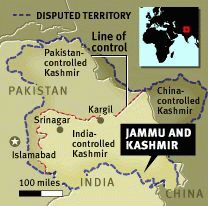 In modern times, there two issues that have hijacked the the world peace - the Palestine and Kashmir disputes. Interestingly both stemmed almost at the same time into the history and have similar cause - injustice to the indigenous people. The Palestinians and the Kashmiris have since been denied to have their own homeland and their voice for independence from the shackles of slavery is being brutally silenced. The very issue has brought the Arabs and Israel, and Pakistan and India to the battle fronts three-four times, but the deadlock continues. This site is focused on the Kashmir dispute, its genesis and the present position. However, the irony of the matter is that while the world community has tried to resolve many such issues by active involvement including the UN, the fate of Kashmir is left to be resolved mutually between India and Pakistan.
In modern times, there two issues that have hijacked the the world peace - the Palestine and Kashmir disputes. Interestingly both stemmed almost at the same time into the history and have similar cause - injustice to the indigenous people. The Palestinians and the Kashmiris have since been denied to have their own homeland and their voice for independence from the shackles of slavery is being brutally silenced. The very issue has brought the Arabs and Israel, and Pakistan and India to the battle fronts three-four times, but the deadlock continues. This site is focused on the Kashmir dispute, its genesis and the present position. However, the irony of the matter is that while the world community has tried to resolve many such issues by active involvement including the UN, the fate of Kashmir is left to be resolved mutually between India and Pakistan.
The Facts:
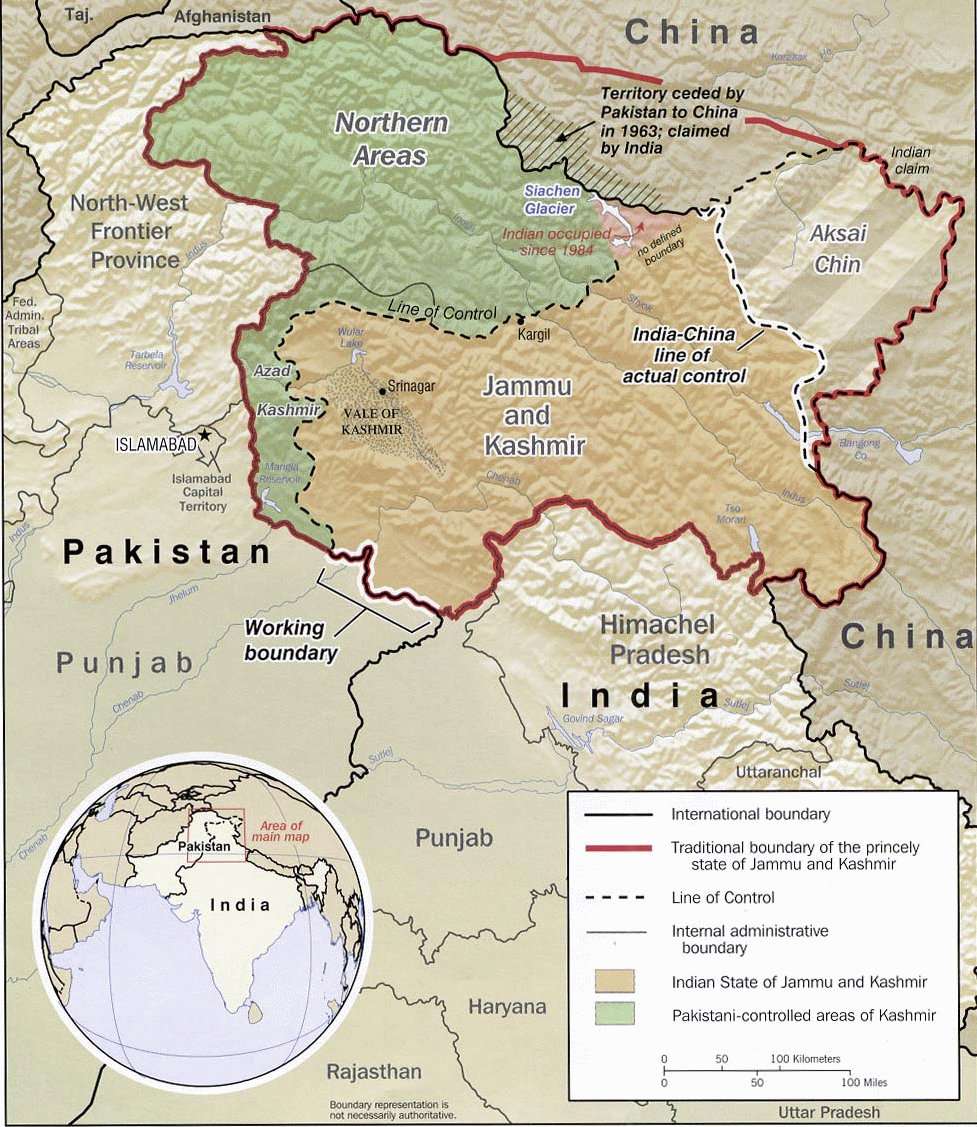
Kashmir is located in the North and North-East of Pakistan, sharing its border with Afghanistan, China and India. Kashmir has been divided into two segments, one under the Indian control and the other under Pakistan. The IHK is further subdivided into three regions: the Valley, Jammu and Ladakh. Kashmir Valley has 4% Hindus and 95% Muslims, while Jammu has Hindu majority (66%) while Muslims are 30% with 4% other religions. Ladakh is 50% Buddhist, 46% Muslims and others 3%. The Azad Kashmir has Muslim majority of almost 99%.
Kashmir Dispute in Historical Perspective: Kashmir has all along a Muslim majority part of the undivided India - an area with 94% Muslim population - but was sold to the Sikhs by the British in 1846 as a reward of their loyalty to the British Empire. Thus began an era of suppression of the Muslims by the rulers of Kashmir which continued till the partition of undivided India in august 1947. In 1931, the people of Kashmir stood up for the first time and protested against the atrocities of Maharajah Hari Singh. This movement led to the "Quit Kashmir" campaign against the Maharajah in 1946. The Muslims of India under Jinnah always dreamt of a separate homeland comprising all Muslim majority areas, including the Kashmir Valley - even the letter "K" in the word "Pakistan" stands for Kashmir when on 23 March 1940, the famous Pakistan resolution was adopted unanimously by the Muslim League - the sole representative political party of all Muslims living in the British India. On July 26, 1946, the Muslim Conference adopted the Azad Kashmir Resolution, calling for the end of autocratic rule in the region. The resolution also claimed for Kashmiris right to elect their own constituent assembly.
The genesis of the issue were first sowed by the British when announcing the partition plan on June 3, 1947, wherein while accepting Muslims' view point of dividing India in a manner that all Muslim majority regions go to the newly formed state of Pakistan and the rest to India. But perhaps at the back of their mind was something else. The boundary commission under Sir Radcliff provided the base - which acceded the Muslim majority district of Gurdaspur to India and was tacitly announced just a few days before the partition. The importance of Gurdaspur is that it provided the only road link between India and Kashmir Valley. This obviously created resentment among the Muslims of the Kashmir Valley and present northern areas of Pakistan.
 Thus an armed struggle started off between the Kashmiri Muslims and the forces of Maharaja Hari Singh. Although, as per the provisions of the independence, the rulers of all independent states were given the option to join either of the two states. Under mounting pressures of the Muslim fighters, the Maharaja opted to join India and asked India for military support. The Indians promised military support provided the Maharaja signed the "Instrument of Accession" document. The moment the document was signed, Indian forces entered Kashmir using Srinagar airfield. Faced with a popular revolt against his rule, the Maharajah fled to Jammu on 25th October 1947 and received a commitment of military assistance from the Indian government in exchange for his signing the "Instrument of Accession" document. Lord Mountbatten conditionally accepted the document on behalf of the British Crown and outlined the conditions for official acceptance in a letter dated 27th October 1947. "In consistence with their policy that in the case of any (native) state where the issue of accession has been subject of dispute, the question of accession should be decided in accordance with the wishes of the people of the state, it is my government's wish that as soon as law and order have been restored in Kashmir and her soil cleared of the invaders the question of state's accession should be settled by a reference to the people." On 1 November 1947 Jinnah categorically announced that Kashmir's accession to India was not "bona fide" when he met Governor General of India, Mountbatten. Interestingly, the following day, Indian Prime Minister, Jawaharlal Nehru, in a speech aired on All-India Radio, reaffirmed the Indian Government's commitment to the right of the Kashmiri people to determine their own future through a plebiscite: "We have declared that the fate of Kashmir is ultimately to be decided by the people. That pledge we have given, and the Maharajah has supported it, not only to the people of Jammu and Kashmir, but also to the world. We will not and cannot back out of it. We are prepared when peace and law have been established to have a referendum held under international auspices like the United Nations. We want it to be a fair and just reference to the people and we shall accept their verdict." However, events thereafter bore testimony to the Indian hypocrisy since till date this promise has not been fulfilled by successive Indian governments.
Thus an armed struggle started off between the Kashmiri Muslims and the forces of Maharaja Hari Singh. Although, as per the provisions of the independence, the rulers of all independent states were given the option to join either of the two states. Under mounting pressures of the Muslim fighters, the Maharaja opted to join India and asked India for military support. The Indians promised military support provided the Maharaja signed the "Instrument of Accession" document. The moment the document was signed, Indian forces entered Kashmir using Srinagar airfield. Faced with a popular revolt against his rule, the Maharajah fled to Jammu on 25th October 1947 and received a commitment of military assistance from the Indian government in exchange for his signing the "Instrument of Accession" document. Lord Mountbatten conditionally accepted the document on behalf of the British Crown and outlined the conditions for official acceptance in a letter dated 27th October 1947. "In consistence with their policy that in the case of any (native) state where the issue of accession has been subject of dispute, the question of accession should be decided in accordance with the wishes of the people of the state, it is my government's wish that as soon as law and order have been restored in Kashmir and her soil cleared of the invaders the question of state's accession should be settled by a reference to the people." On 1 November 1947 Jinnah categorically announced that Kashmir's accession to India was not "bona fide" when he met Governor General of India, Mountbatten. Interestingly, the following day, Indian Prime Minister, Jawaharlal Nehru, in a speech aired on All-India Radio, reaffirmed the Indian Government's commitment to the right of the Kashmiri people to determine their own future through a plebiscite: "We have declared that the fate of Kashmir is ultimately to be decided by the people. That pledge we have given, and the Maharajah has supported it, not only to the people of Jammu and Kashmir, but also to the world. We will not and cannot back out of it. We are prepared when peace and law have been established to have a referendum held under international auspices like the United Nations. We want it to be a fair and just reference to the people and we shall accept their verdict." However, events thereafter bore testimony to the Indian hypocrisy since till date this promise has not been fulfilled by successive Indian governments.
India and Pakistan went to war over Kashmir from 1947-48. When India could not find a way out of the problem, India brought the Kashmir issue to UN Security Council in January 1948. The rebel forces had been joined by volunteers from Pakistan and India charged Pakistan with having sent "armed raiders" into the state. It demanded that Pakistan be declared an aggressor in Kashmir. Furthermore, India demanded that Pakistan stop aiding freedom fighters, and allowing the transit of tribesmen into the state. After acceptance of these demands, coupled with the assurance that all "raiders" were withdrawn, India would allow a plebiscite to be held under impartial auspices to decide Kashmir's future status. The Security Council discussed the question from January until April of 1948. It came to the conclusion that it would be impossible to determine responsibility for the fighting and futile to blame either side. Since both parties desired that the question of accession should be decided through an impartial plebiscite, the council developed proposals based on the common ground between them. These were embodied in the resolution of 21st April 1948, envisaging:
-
An immediate cease-fire,
-
Withdrawal of all outside forces from the state, and
-
A plebiscite under the control of an administrator who would be nominated by the Secretary General.
For negotiating the details of the plan, the council constituted a five-member commission known as "United Nations Commission for India and Pakistan," (UNCIP) to implement the resolution. After the cease-fire, India began efforts to drag the issue down, and under various pretexts tried to stop the UN resolution from being implemented. To this day, India pursues the same plan, and the resolution of 1948 has yet to be realized. The UN also deployed the United Nations Military Observer Group (UNMOGIP) to monitor the cease-fire line between the Liberated or Azad Kashmir area and the Indian Held Kashmir (IHK).
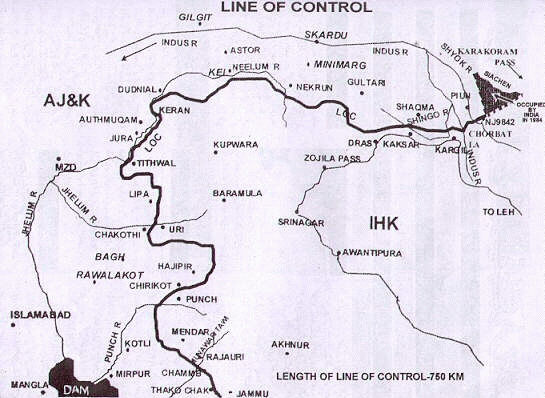
However, despite UN resolutions, there has been no solution to the problem and India and Pakistan fought two more wars in 1965 and 1971. But no solution has since been found since India continues to maintain its right over entire Kashmir, even the portion held by Pakistan. The views of Indian Defence Minister Krishan Menon are worth quoting here who in February 1957 said," "I wish to make it clear on behalf of my government that in no circumstances we can agree to the holding of a plebiscite in Kashmir." After 1971 Indo-Pak war, Pakistan and India signed the famous Simla Agreement and agreed to make efforts toward establishing durable peace by seeking a solution to existing problems, including "a final settlement of Jammu and Kashmir." And so much for the the dispute, since the status quo continues till date.
After more than four decades of a peaceful struggle against Indian repression, manipulation and exploitation, the Kashmiri people, convinced that India would never honour its commitments, and inspired by similar movements for freedom in other parts of the world, rose against the Indian occupation towards the later part of 1989. Their struggle was, and remains, largely peaceful. India sought to suppress their movement with massive use of force, killing hundreds of innocent men, women and children. This led some of the Kashmiri youth to take up arms in self defence. Since 1989, more than 60,000 Kashmiri people have been killed in a reign of terror and repression unleashed by over 600,000 Indian troops. Many more languish in Indian jails where they are subjected to torture and custodial deaths. There have been numerous cases of gang rapes of Kashmiri women by the Indian forces and the deliberate burning down of entire localities and villages.
The recent initiatives by the President of Pakistan of total withdrawal of troops from Kashmir and joint control of Kashmir have also not been accepted and the stalemate continues despite the recent on going dialogues between Pakistan and India wherein India is ready to discuss any issue less Kashmir.
Mega Projects of Pakistan
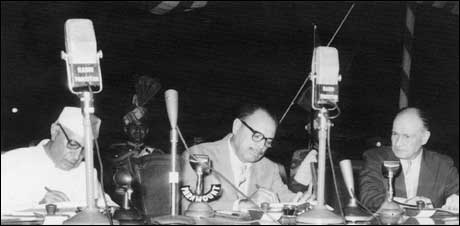
The Beginning of the Mega Projects in Pakistan - the signing of Indus Basin Water Treaty -1960
Indus Basin Water Treaty 1960
At the time of partition of India and Pakistan, there arose a dispute on the use of water resources since all rivers flowing in to Pakistan originated from India. The accord signed in 1960 at Karachi, Pakistan gave water of Indus, Jhelum and Chenab to Pakistan, whereas Ravi and Beas (Sutlej in Pakistan) were to be used by India. The treaty was signed by Pakistani president Ayub Khan and Indian prime minister Nehru. Consequent to this agreed upon distribution, decision was taken to build to big water storages on the Indus (Tarbela Dam) and Jhelum (Mangla Dam) rivers. Thereafter, many small dams have also been added. In 90s, Ghazi Barotha project came up without constructing a water reservoir for generating electricity.
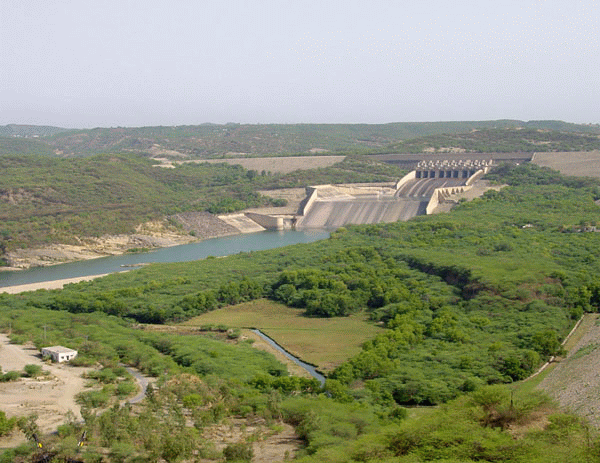
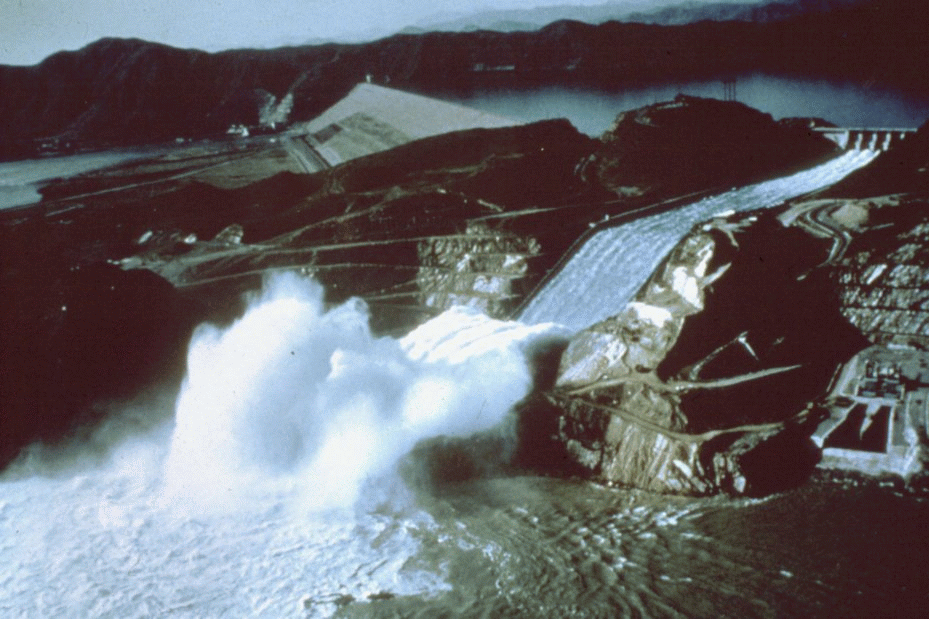
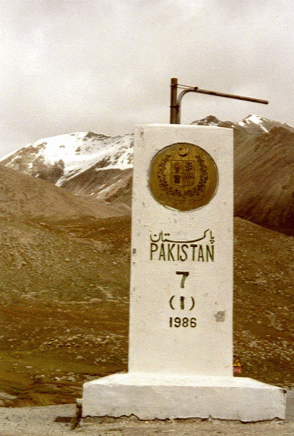
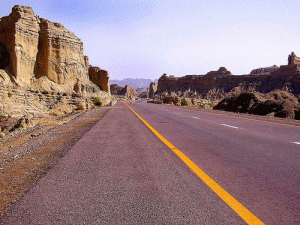
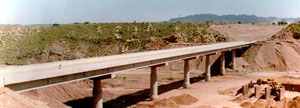
Left to Right: Mangla Dam - Tarbela Dam - KKH - Makran Coastal Highway - Motorway M2
Highways and Motorways
Pakistan inherited a poor infrastructure of road network throughout the country. With the passage of time, the road network has been considerable been improved. The construction of first mega project in this sector was the Super Highway connecting Karachi and Hyderabad in the province of Sind. Much later, the marvel of road construction saw coming up of the Karakoram Highway (KKH) connecting Pakistan to China over some of the rugged mountains of the world along the gushing and roaring river Indus. Then came the era of Motorways in the 90s with the construction of M-2, connecting Lahore and Islamabad. This chain is now been extended to many other destinations and is still expanding. The recent addition is the Coastal Highway, connecting Karachi to the newly developed port of Gwadar along the Makran coast skirting the Arabian Sea.
Sea Ports
Since 1947, Pakistan has had only one sea port at Karachi, which has been under tremendous pressure to bear the burden of all export and import related activities. Karachi. Although Pakistan has a long stretch of coastline along the Arabian Sea from the Sir Creek in the east to Gwader in the west, no worthwhile effort had been put to increase the outlets to the sea. Port Bin Qasim, some 35 kilometres west of Karachi was the second outlet added mainly to import raw material for the only Steel Mills of the country. Later Pakistan Navy constructed and developed a new base for itself at Ormara. Now work is underway to develop a deep sea port at Gwader, just at the mouth of the Persian Gulf, which would go a long way in reducing shipping costs for all imports, specially crude oil from the Gulf states as well as providing a short cut to warm waters to CARs, Afghanistan and China in the north.
Future Requirement of Water and Construction of Big Dams
Presently, out of a total of 77 million acres of cultivable land in Pakistan, only only 44 million acres is under cultivation due to sacristy of water, which is to the magnitude of 9 MAF. Due to silting of Mangla and Tarbela Dams, water capacity is reducing @ 3.6 MAF and if this trend continues, there will be a shortfall of 25 MAF of water by 2020. Although the present government has undertaken a gigantic task of brick lining the small water courses from canals to farms, this would be able to save only 5 MAF of water, leaving a net shortfall of 15-20 MAF of water. Unless, 3-5 major dams are built by 2016, Pakistan will have left with no water to irrigate its lands. Therefore the cabinet has recently decided to build five major dams on the Indus and other rivers to save excess water running down the Indus into Arabian Sea.
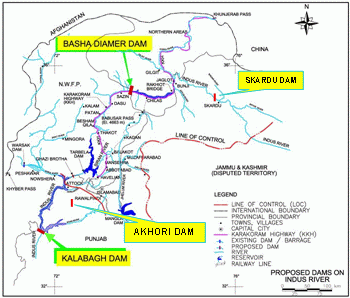
The proposed dams on the Indus include Skardu, Bhasha, Akhori and Kalabagh dams. Out of these Kalabagh Dam has been much controversial, specially by the NWFP and Sind provinces. Therefore , for the time being the government has decided to go ahead with the construction of Bhasha and Munda Dams, both located in the NWFP.
Comparison - Skardu, Bhasha, Akhori and Kalabagh Dams
All mega dams planned on River Indus are equally important - however, Skardu Dam being far up in the north may prove to be expensive since the transmission losses from extended power lines will be more besides submerging of Skardu city.
Bhasha Dam will have a live storage capacity of 7.30 MAF and installed power generation capacity of 4500 megawatts. It will store only 50 MAF glacial water from the northern mountains. Estimated cost $ 6.5 billion.
Kalabagh Dam is planned to be constructed below Akhori (Talagang) with a live storage capacity of 6.1 MAF and installed capacity of maximum 3,600 megawatts at an estimated cost of 6.1 billion $. Unlike Bhasha, it will also have 90 MAF water inlet from Soan, Kabul, Chitral and Haro rivers and thus will be able to store the monsoon water from these additional rivers.
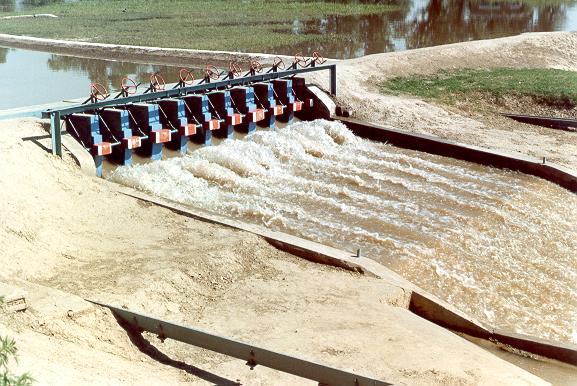
Physical Model of Kalabagh Dam
Akhori Dam near Talagang will be able to store 6 MAF while water available will be 14 MAF with an installed capacity of 600 megawatts.
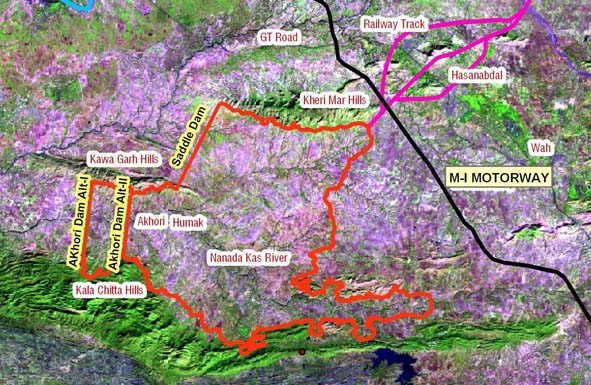
Skardu Dam is presently under study and hence most of the data is only approximate. The water available will be 27 MAF.
Munda Dam is a prelude to the construction of Kalabagh Dam, basically designed to save Nowshera from flooding and to alleviate any misgivings the people of NWFP may have on the construction of Kalabagh Dam, which must be built to store all downstream rain/monsoon water which gets wasted away due to non availability of any water storage reservoir downstream Kalabagh.
Water Disputes with India
Since the Indus Basin Treaty, India has been violating it in one way or the other. The Baglihar Dam being the latest incursion on the water being made available to Pakistan from the Chenab river. As per the Treaty, India is not allowed to build storage or diversion of the river water. However, under the garb of only installing hdro-electricity generation capability, India has planned construction in such a way that the site can store the river water and can thus be controlled to her advantage. Presently, the World Bank is monitoring the issue and no decision has yet been taken.
میرا نیا بلاگ - اپنی رائے کا اظہار کیجئے
http://shoaibtanoli.wordpress.com/
Regards
M Shoaib TaNoLi
Karachi Pakistan
Email@ shoaib.tanoli@gmail.com
Cell # +92-300-2591223
Facebook :https://www.facebook.com/mtanoli
SKYPE: shoaib.tanoli2
پاکستان زندہ باد ۔ پاکستان پائندہ باد
Long Live Pakistan
Pakistan Zindabad!
Dear Readers: My mails are my personal choice. The purpose of these mails is to establish contact with you, make you aware of different cultures ,disseminate knowledge and information. If these (mails) sound you unpleasant, please intimate .
IF YOU ARE NOT INTERESTED IN MY MAIL
PLEASE REPLY THIS E_,MAIL WITH THE SUBJECT.. UNSUBSCRIBE
E Mail: shoaib.tanoli@gmail.com
--
پاکستان کسی بھی پاکستانی کے لئے اللہ کی سب سے بڑی نعمتوں میں سے ایک ہے. آج ہم جو بھی ہے یہ سب اس وجہ پاکستان کی ہے ، دوسری صورت میں ، ہم کچھ بھی نہیں ہوتا. براہ مہربانی پاکستان کے لئے مخلص ہو.
* Group name:█▓▒░ M SHOAIB TANOLI░▒▓█
* Group home page: http://groups.google.com/group/MSHOAIBTANOLI
* Group email address MSHOAIBTANOLI@googlegroups.com
To unsubscribe from this group, send email to
MSHOAIBTANOLI+unsubscribe@googlegroups.com
*. * . * . * . * . * . * . * . * . * . *
*. * .*_/\_ *. * . * . * . * . * . * . * . * .*
.•´¸.•*´¨) ¸.•*¨) ¸.•´¸.•*´¨) ¸.•*¨)
(¸.•´ (¸.•` *
'...**,''',...LOVE PAKISTAN......
***********************************
Muhammad Shoaib Tanoli
Karachi Pakistan
Contact us: shoaib.tanoli@gmail.com
+923002591223
Group Moderator:
*Sweet Girl* Iram Saleem
iramslm@gmail.com
Face book:
https://www.facebook.com/TanoliGroups
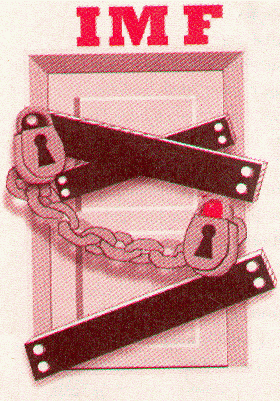 For years since 1970 onwards, Pakistan had a poor track record of saving and heavy dependence on the IMF and the World Bank for assistance in developing its basic infrastructure. However, in recent years, the government has taken some prudent mid to long term steps to revive its economy, which has started showing its results. Perhaps for the first time in its history, Pakistan has not only repaid sizeable portion of its foreign debt, but has also decided not to take any more loans. The country's GDP now stands at 4% from 2% in the 90s. The on going peace talks with India have further reduced the tension between the two countries, which has given boost to its economy and foreign trade. Pakistan now stands at the cross roads and hopes of better future are in sight - a fact now often acknowledged by the world economic bodies.
For years since 1970 onwards, Pakistan had a poor track record of saving and heavy dependence on the IMF and the World Bank for assistance in developing its basic infrastructure. However, in recent years, the government has taken some prudent mid to long term steps to revive its economy, which has started showing its results. Perhaps for the first time in its history, Pakistan has not only repaid sizeable portion of its foreign debt, but has also decided not to take any more loans. The country's GDP now stands at 4% from 2% in the 90s. The on going peace talks with India have further reduced the tension between the two countries, which has given boost to its economy and foreign trade. Pakistan now stands at the cross roads and hopes of better future are in sight - a fact now often acknowledged by the world economic bodies. 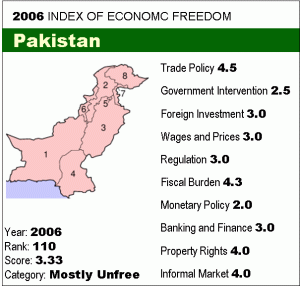 Index of Economic Freedom: There are yet other signs of recovery in the economy of Pakistan. Recently, the Index of "economic freedom" has placed Pakistan on the 110th slot in the current year (2006), considerably higher than the 133rd position on which it stood in 2005, on a scale of 1-155.
Index of Economic Freedom: There are yet other signs of recovery in the economy of Pakistan. Recently, the Index of "economic freedom" has placed Pakistan on the 110th slot in the current year (2006), considerably higher than the 133rd position on which it stood in 2005, on a scale of 1-155.
No comments:
Post a Comment